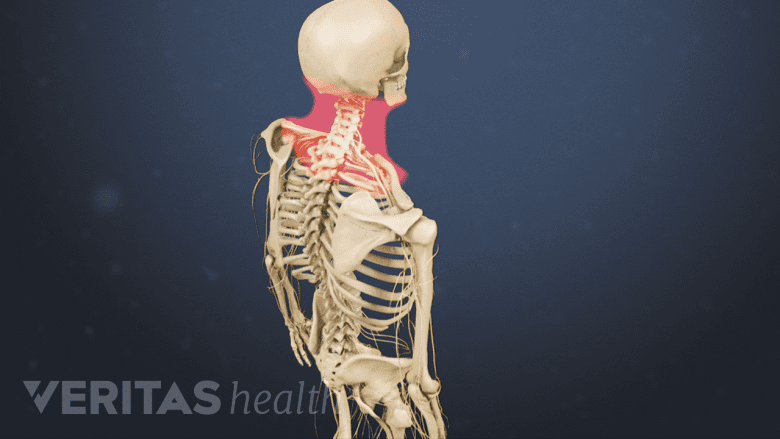Massage therapy commonly involves using the hands to manipulate soft tissues, such as the muscles and tendons, to increase blood circulation, reduce muscle tension, and promote feelings of improved wellbeing. For people who have chronic neck pain and stiffness, it is common to seek massage therapy from a massage therapist, physical therapist, or other qualified health professional.
In This Article:
How Massage Therapy Works for Chronic Neck Pain

Massage may help loosen tight muscles, relax soft tissues, and induce a calming effect.
There are numerous types of massage, with variations in techniques, strokes, and pressure applied by the hands and other methods. Even in cases where only the neck is symptomatic, the massage is typically applied to the neck, shoulders, and back, because these regions are all connected.
Two of the more common types of massage to address neck pain include:
Swedish massage is the most common type in Western culture. It mostly focuses on long, steady strokes, which are typically performed in the direction of blood flow to the heart. Kneading and friction motions may also be included. One of the main goals of Swedish massage is to promote relaxation throughout the entire body.
Deep tissue massage typically uses deeper strokes and friction to work on deeper layers of the muscles and connective tissues. Also known as connective tissue massage, there are a wide variety of definitions for deep tissue massage, depending on the therapist’s techniques and philosophies. Compared to Swedish massage, a deep tissue massage commonly focuses more on an area of chronic pain.
Numerous other types of massage and variations also exist. For example, some massage therapists use special oils or other scents for aromatherapy, which in some cases might enhance the relaxation or enjoyment.
Efficacy of Massage Therapy
Some studies have found that neck massage can provide some neck pain relief and improved range of motion, especially when performed by a trained professional a few times a week for several weeks. These results tend to be temporary.1Nahin RL, Boineau R, Khalsa PS, Stussman BJ, Weber WJ. Evidence-based evaluation of complementary health approaches for pain management in the United State. Mayo Clin Proc. 2016; 91(9):1292-1306. doi: 10.1016/j.mayocp.2016.06.007.,2Field T, Diego M, Gonzalez G, Funk CG. Neck arthritis pain is reduced and range of motion is increased by massage therapy. Complement Ther Clin Pract. 2014; 20(4):219-23. doi: 10.1016/j.ctcp.2014.09.001.
While some studies have found benefits for treating neck pain and stiffness with massage, other studies have not. Further complicating matters, there are a wide variety of massage therapy types and challenges with measuring how massage therapy is applied, which can make it a difficult treatment to study. Some research has indicated that applying a moderate-level massage is more beneficial than a light-touch massage.3Field T, Diego M, Hernandez-Reif M. Moderate pressure is essential for massage therapy effects. Int J Neurosci. 2010; 120(5):381-5. doi: 10.3109/00207450903579475.
More research is needed to determine whether neck massage is beneficial for reducing chronic neck pain and stiffness, and whether the results can be sustained. Even though massage benefits may be temporary, it may still play a role in managing painful flare-ups and helping to improve quality of life.
Risks of Massage Therapy

After a massage, some people may experience temporary neck soreness or swelling.
Massage therapy for the neck is a relatively safe treatment. Some people may experience increased neck soreness and/or swelling shortly after a massage, but these side effects typically do not last long. In rare cases when a massage is applied too hard or if a preexisting injury exists in the neck, massage can lead to serious complications, such as vertebral artery damage and stroke.
To experience the soothing effects of a neck massage, most people do not need the massage to be vigorous. If a massage feels uncomfortable or too rough, it is advised to let the practitioner know immediately so the intensity can be reduced.
- 1 Nahin RL, Boineau R, Khalsa PS, Stussman BJ, Weber WJ. Evidence-based evaluation of complementary health approaches for pain management in the United State. Mayo Clin Proc. 2016; 91(9):1292-1306. doi: 10.1016/j.mayocp.2016.06.007.
- 2 Field T, Diego M, Gonzalez G, Funk CG. Neck arthritis pain is reduced and range of motion is increased by massage therapy. Complement Ther Clin Pract. 2014; 20(4):219-23. doi: 10.1016/j.ctcp.2014.09.001.
- 3 Field T, Diego M, Hernandez-Reif M. Moderate pressure is essential for massage therapy effects. Int J Neurosci. 2010; 120(5):381-5. doi: 10.3109/00207450903579475.


